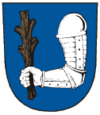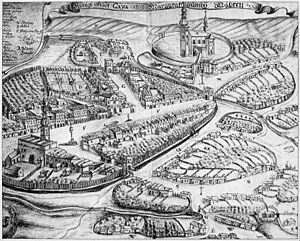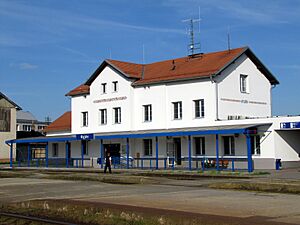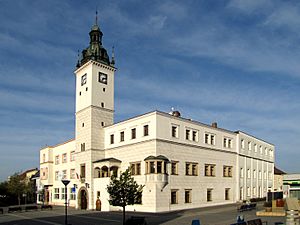Kyjov facts for kids
Quick facts for kids
Kyjov
|
|||
|---|---|---|---|
|
Town
|
|||
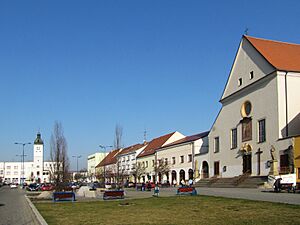
Masarykovo Square
|
|||
|
|||
| Country | |||
| Region | South Moravian | ||
| District | Hodonín | ||
| First mentioned | 1126 | ||
| Area | |||
| • Total | 29.88 km2 (11.54 sq mi) | ||
| Elevation | 192 m (630 ft) | ||
| Population
(2024-01-01)
|
|||
| • Total | 10,799 | ||
| • Density | 361.41/km2 (936.05/sq mi) | ||
| Time zone | UTC+1 (CET) | ||
| • Summer (DST) | UTC+2 (CEST) | ||
| Postal code |
697 01
|
||
Kyjov is a lovely town in the Czech Republic. It's located in the South Moravian Region, specifically in the Hodonín District. About 11,000 people live here. Kyjov has a beautiful old town center that is kept safe as a special historic area.
Contents
Geography of Kyjov
Kyjov is about 17 kilometers (10.5 miles) north of Hodonín. Most of the town is in the Kyjov Hills. A smaller part to the north is in the Chřiby highlands.
The highest point near Kyjov is Lenivá hora hill. It stands 463 meters (1,519 feet) above sea level. The town itself is in the valley of the Kyjovka River.
History of Kyjov
The first time Kyjov was mentioned in writing was in the year 1126. For many years, until 1539, it belonged to the Hradisko Monastery. In the 12th century, a Romanesque church and a new market area were built here.
In 1201, Kyjov was first called a "market town." This meant it was a place where people could trade goods. Later, in 1284, King Wenceslaus II allowed the town to build defenses. Kyjov didn't have enough money for stone walls, so they built wooden fences called palisades instead.
Becoming a Royal Town
During the 1300s and 1400s, the monastery had money problems. Because of this, Kyjov was given to different noble families for a while. In 1515, Kyjov officially became a town.
The monastery sold the town in 1539. After changing owners a few times, Kyjov became a "royal town" in 1548. This was a big deal! The king promised not to sell or give away the town again. This special status helped Kyjov grow and become more successful.
The town fixed its buildings and built three town gates. They also built a new town hall in the Renaissance style. Kyjov gained new land and became stronger.
Later Years and Growth
In 1710, the first Capuchin monks arrived in Kyjov. They built a new church. However, their monastery was closed down in 1784.
From 1784 to 1848, Kyjov was doing very well economically. The town grew and expanded. In the late 1800s, a small group of people in Kyjov spoke German, including some Jewish families. Until 1918, Kyjov was part of Austria-Hungary.
Population of Kyjov
As of 2024, Kyjov has about 10,799 people. The average age of people living in Kyjov is 46.4 years. This makes it one of the towns with an older population in the Czech Republic. It's the oldest among towns with more than 10,000 people.
| Historical population | ||||||||||||||||||||||||||||||||||||||||||||||||||||||||
|---|---|---|---|---|---|---|---|---|---|---|---|---|---|---|---|---|---|---|---|---|---|---|---|---|---|---|---|---|---|---|---|---|---|---|---|---|---|---|---|---|---|---|---|---|---|---|---|---|---|---|---|---|---|---|---|---|
|
|
|
||||||||||||||||||||||||||||||||||||||||||||||||||||||
| Source: Censuses | ||||||||||||||||||||||||||||||||||||||||||||||||||||||||
Transportation in Kyjov
Kyjov is on a railway line that connects Brno to Uherské Hradiště. The town has three train stations and stops. These are called Kyjov, Kyjov zastávka, and Bohuslavice u Kyjova.
Culture and Traditions
Kyjov is a very important place for regional folklore. Folklore means the traditional beliefs, customs, and stories of a community. The town is in a cultural area called Moravian Slovakia.
The Slovácký rok festival, which means "Moravian Slovakian Year," is the oldest folklore festival in Moravia. It has been held in Kyjov every four years since 1921. It's a big celebration of local traditions!
In 2008, Kyjov won a silver medal in the Entente Florale Europe competition. This is an international contest about how beautiful towns are with their plants and gardens.
Main Sights to See
The historic center of Kyjov is around Masarykovo Square. In the middle of the square, there is a Marian column from the 1720s. This is a tall monument with a statue of the Virgin Mary.
Kyjov Town Hall
The most important building on the square is the Renaissance town hall. Italian architects built it in 1561–1562. It has special decorations called sgraffiti, which are designs scratched into plaster. The town hall also has a tall tower that is 39 meters (128 feet) high. Since 2024, it has been recognized as a national cultural monument.
Church of the Assumption
The Church of the Assumption of the Virgin Mary is also on the town square. It was built between 1713 and 1720 and made bigger in 1734. Below the church, there is a Capuchin tomb. It holds 40 coffins.
Kyjov Chateau
The Chateau is the oldest building still standing in Kyjov. It was built in the early 1500s as a large house for a wealthy family. Over time, it was used for different things. In 1911, it was renovated and decorated with sgraffiti. Since 1928, the Chateau has been home to the Kyjov Ethnographic Museum. This museum shows off old items, cultural traditions, and natural science exhibits from the area.
Famous People from Kyjov
- Ervin Rössler (1876–1933), a zoologist who studied animals.
- Hugo Sonnenschein (1889–1953), an Austrian writer.
- Radola Gajda (1892–1948), a military leader and politician who studied here.
- Bohumil Sekla (1901–1987), a biologist and university professor.
- Miroslav Novák (1907–2000), a religious leader.
- Miroslav Tichý (1926–2011), a painter and photographer.
- Ivo Knoflíček (born 1962), a famous footballer.
- Roman Stantien (born 1964), a Slovak ice hockey player.
- Jan Bárta (born 1984), a road cyclist.
- Jakub Kornfeil (born 1993), a motorcycle racer.
Kyjov's Sister Cities
Kyjov has "sister city" relationships with several towns around the world. This means they share cultural ties and friendly connections.
 Biograd na Moru, Croatia
Biograd na Moru, Croatia Hollabrunn, Austria
Hollabrunn, Austria Lutsk, Ukraine
Lutsk, Ukraine Prizren, Kosovo
Prizren, Kosovo Seravezza, Italy
Seravezza, Italy Yvetot, France
Yvetot, France
See also
 In Spanish: Kyjov para niños
In Spanish: Kyjov para niños



